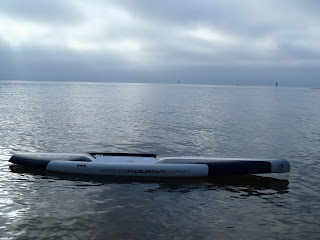
Racked and Ready
One of the coolest things about SUP is introducing and teaching a whole new new group of people about the world of board sports.
It has come to our attention, a lot of newbies are dazed and confused on how to carry boards on their car.
I've been carrying stuff on the roof of my car so long, it is natural to me and I feel naked without something up there!
What follows is some basic instruction on how to transport board(s) safely and securely. It is simple, trust me.
First you are going to need something on the roof of your car to set the board down on. Many cars come with "factory racks", and in most cases, these are sufficient for carrying Stand Up Boards. If your vehicle doesn't have a rack, you will need to purchase a rack system. A rack system consists of two cross bars, and a foot to anchor those bars to the roof of your car. We sell the Thule Racks and will be happy to get and install the correct rack for your car.
Roof Racks
Once you have a rack on your car, you are going to need some
pads and
tie down straps .
There are several companies making (or marketing) "SUP Carriers". WAAAAY too complicated and/or expensive. Trust me!
All you need is a set of 24" or 30" pads. These will cradle and protect your board. They also help keep your board from sliding on the rack.
Rack Pads
Next you will need a set of tie down straps. Our East of Maui straps are simple, and they work. Some of the ratchet type straps customers bring in work well for securing a load of lumber on your semi truck, but they are seriously overkill can damage your board. You might consider a pair of locking straps, but we will get to that later.
Tie Down Straps
Now that you have racks, pads and straps, it is time to put your board on the car. There is only one WRONG WAY to carry the board. Right side up and nose forward is a BIG NO NO. I find boards ride best on my truck upside down and tail forward. If I'm stacking boards, each board goes on with the tail just behind the fin of the board underneath. It is not a bad idea to use stacking pads between your boards. Upside down fin back, and even right side up and tail forward is OK, but PLEASE don't carry your board right side up and nose forward.
Stack Pads
Now that you know how to set the board on the rack, it is time to strap it down. Once again it is simple and doesn't have to be complicated.
Step One: go around the crossbar and pass both the buckle end and the opposite end
over the board.

#1
Step Two: Position the buckle either flat on the the board or along side of it. Pass the opposite end around and underneath the cross bar, then back up to and through the buckle. Pull the straps just snug enough to keep the board from moving. DO NOT pull as hard as you can! Once again just snug enough to keep the board from moving. (Repeat step one and two on the other cross bar.)
#2
Step Three: Secure the loose end of the straps. I usually wrap up the extra strap around the bar, or for short trips you can toss it in car and close the door on it. Check everything one last time.
#3
Almost Ready to Roll!
Other things to consider for storage and transportation.
Board bags give you a little more padding and help protect your boards from general banging around, sunlight, bugs , and other travel hazards. However, boards can get HOT in a bag. If your board comes equipped with a vent screw, it should definitely be
open when the board is in the bag, just be sure to
close the vent before hitting the water.
If you have to leave your board on the roof , there are a couple different ways to lock the board to the rack. I'm a big fan of the Steel Core lockable ties downs and the Dock's Lock cable system. While the"professional" thief can get anything they want, these locks will go a long way to protect your investment from walking off.



Whether you are just getting into board sports, or have been doing it a long time, East of Maui has everything you need to transport your boards safely and securely. We are open seven days a week for all your SUP and board sport needs.
Happy Motoring!


























